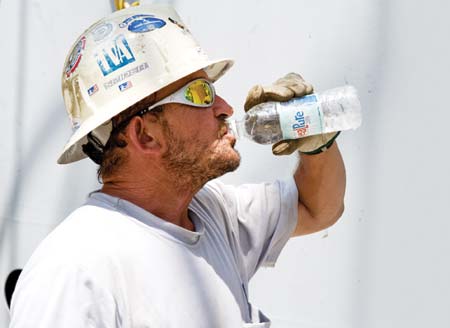Following last year's deaths, the TUC published a new briefing on temperature; 'Heat - The Case For a Maximum Temperature at Work'. The briefing states that when temperatures get too high, a health and safety issue is created. When people become too hot they risk dizziness, fainting and even heat cramps. In extreme heat the body's blood temperature rises. If this goes over 39°C there is a risk of heat stroke or collapse. Blood temperature at this level can be fatal or cause lasting organ damage.
In the briefing the TUC calls for a legal duty to be placed on employers to protect outdoors workers by providing sun protection, water and by arranging working hours so that workers are not outside during the hottest part of the day.

Working in hot conditions can also escalate existing safety risks. Heat is linked with lower mental alertness and physical performance and thus contributes to more accidents. Raised body temperature and physical discomfort can also cause employees to divert their attention away from the task at hand, the risks present and to overlook everyday safety procedures.
Some workers are exposed to heat all year round, such as welders and those working in glass manufacture, boiler rooms etc. Whilst heat is often considered a summer problem, some employers may need to take preventative measures throughout the year.
Reducing Heat and Protecting Employees.
In your workplace risk assessment remember to include issues of thermal comfort.
When carrying out the risk assessment, look at;
• Work rate: The harder someone is working the more heat they will be generating
• Working climate: Including air temperature, humidity, air movement, effects of working near a heat source
• Workwear, clothing and RPE: May impair efficiency of sweating and other means of temperature regulation
• A workers age, build and medical factors which may affect their tolerance
Speak with workers and their safety representative and find out if they are suffering any early signs of heat stress; loss of concentration, muscle cramps, heat rash, feeling faint, nausea, headache etc. If it seems likely that there is a problem, consult with people who are more experienced at determining the risk from hot environments such as an occupational hygienist or doctor.
Reducing the Risk:
Remove or reduce the sources of heat where possible or control the temperature with engineering solutions such as;
• changing the processes
• use fans or air conditioning
• use physical barriers that reduce exposure to radiant heat
Providing mechanical aids wherever possible will help to reduce employees work rate meaning they do not generate so much body heat. You could also find ways, where possible, to reduce the amount of time employees spend in the problem area or allow them only to enter a certain area when the temperature has dropped to a safe level. If this is not possible provide regular rest breaks and a rest facility in a cooler environment.

Provide a good supply of water to employees and encourage them to drink regular small amounts, where this is safe to do so. To aid comfort you could also provide workwear in a cooling, breathable fabric. Train your employees about the risks of heat stress in their job and ensure they understand the signs and symptoms, safe working practices and emergency procedures. Identify workers who are most susceptible and monitor the health of those at risk.
No comments:
Post a Comment